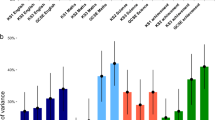Abstract
Asian achievement is now recognized to be global in manifestation. Yet most explanations of group differences remain narrowly focused on one country (the U.S.A.), on one character (test scores), and from one viewpoint (environmentalism). I offer an evolutionary perspective. Genetic distance estimates indicate an African origin for humans about 200,000 years ago, a dispersal event out of Africa about 110,000 years ago, and a Mongoloid-Caucasoid split about 41,000 years ago. This racial succession is matched by cranial capacities, IQ test scores, speeds of decision time, and numerous other life-history variables including rate of physical maturation, family functioning, testosterone level, law-abidingess, and frequency of dizygotic twinning. Evolutionary selection pressures are more cognitively demanding in the cold arctic where mongoloids evolved than in the hot savanna where Africans evolved. Genetic theories are needed to explain the proportionate group differences.
Similar content being viewed by others
References
Andreasen, N. C., Flaum, M., Swayze, V., O'Leary, D. S., Alliger, R., Cohen, G., Ehrhardt, J., and Yuh, W. T. C. (1993). Intelligence and brain structure in normal individuals.Am. J. Psychiat. 150: 130–134.
Beals, K. L., Smith, C. L., and Dodd, S. M. (1984). Brain size, cranial morphology, climate and time machines.Curr. Anthropol. 25: 301–330.
Broman, S. H., Nichols, P. L., Shaughnessy, P., and Kennedy, W. (1987).Retardation in young children, Erlbaum, Hillsdale, NJ.
Bulmer, M. G. (1970).The Biology of Twinning in Man, Clarendon Press, Oxford.
Clark, E. A., and Hanisee, J. (1982). Intellectual and adaptive performance of Asian children in adoptive American settings.Devel. Psychol. 18: 595–599.
Frydman, M., and Lynn, R. (1989). The intelligence of Korean children adopted in Belgium.Person. Indiv. Diff. 10: 1323–1325.
Ho, K. C., Roessmann, U., Straumfjord, J. V., and Monroe, G. (1980). Analysis of brain weight: I and II.Arch. Pathol. Lab. Med. 104: 635–645.
Jensen, A. R. (1985). The nature of the Black-White difference on various psychometric tests: Spearman's hypothesis.Behav. Brain Sci. 8: 193–263.
Jensen, A. R. (1987). Theg beyond factor analysis. In Connoley, J. C., Glover, J. A., and Ronning R. R. (eds.),The Influence of Cognitive Psychology on Testing and Measurement, Erlbaum, Hillsdale, NJ, pp. 87–142.
Jensen, A. R. (1993). Spearman's hypothesis tested with chronometric information-processing tasks.Intelligence 17: 47–77.
Jensen, A. R., and Johnson, F. W. (1994). Race and sex differences in head size and IQ.Intelligence, 18: 309–333.
Jensen, A. R., and Whang, P. A. (1993). Reaction times and intelligence: A comparison of Chinese-American and Anglo-American children.J. Biosoc. Sci. 25: 397–410.
Levin, M. (1995). Does Race Matter?Amer. Psychol 50: 45–46.
Lynn, R. (1991). Race differences in intelligence: A global perspective.Mankind Quart. 31: 255–296.
Lynn, R., and Shigehisa, T. (1991). Reaction times and intelligence: A comparison of Japanese and British children.J. Biosoc. Sci. 23: 409–416.
Raz, N., Torres, I. J., Spencer, W. D., Millman, D., Baertschi, J. C., and Sarpel, G. (1993). Neuroanatomical correlates of age-sensitive and age-invariant cognitive abilities: Anin vivo MRI investigation.Intelligence 17: 407–422.
Rushton, J. P. (1989). Japanese inbreeding depression scores: Predictors of cognitive differences between Blacks and Whites.Intelligence 13: 43–51.
Rushton, J. P. (1990). Race and crime: A reply to Roberts and Gabor.Can. J. Criminol. 32: 315–334.
Rushton, J. P. (1992a). Contributions to the history of psychology: XC. Evolutionary biology and heritable traits (with reference to Oriental-White-Black differences): The 1989 AAAS paper.Psychol. Rep. 71: 811–821.
Rushton, J. P. (1992b). Cranial capacity related to sex, rank and race in a stratified random sample of 6325 U.S. military personnel.Intelligence 16: 401–413.
Rushton, J. P. (1992c). Life history comparisons between Orientals and Whites at a Canadian university.Person. Indiv. Diff. 13: 439–442.
Rushton, J. P. (1995).Race, Evolution and Behavior: A Life History Perspective. Transaction Publishers, New Brunswick, NJ.
Rushton, J. P. (1994). Sex and race differences in cranial capacity from International Labour Office Data.Intelligence, 19: 281–294.
Ubelaker, D., and Scammel, H. (1992).Bones: A Forensic Detective's Casebook. HarperCollins, New York.
Weinberg, R. A., Scarr, S., and Waldman, I. D. (1992). The Minnesota transracial adoption study: A follow-up of IQ test performance at adolescence.Intelligence 16: 117–135.
Wickett, J. C., Vernon, P. A., and Lee, D. C. (1994):In vivo brain size, head perimeter, and intelligence in a sample of healthy adult females.Person. Indiv. Diff. 16: 831–838.
Willerman, L., Schultz, R., Rutledge, J. N., and Bigler, E. D. (1991).In vivo brain size and intelligence.Intelligence 15: 223–228.
Winick, M., Meyer, K. K., and Harris, R. C. (1975). Malnutrition and environmental enrichment by early adoption.Science 190: 1173–1175.
Yee, A. H. (1992). Asians as sterotypes and students: Misperceptions that persist.Educ. Psychol. Rev. 4: 95–132.
Yee, A. H., Fairchild, H. H., Weizmann, F., and Wyatt, G. E. (1993). Addressing psychology's problems with race.Am. Psychol. 48: 1132–1140.
Author information
Authors and Affiliations
Rights and permissions
About this article
Cite this article
Rushton, J.P. Asian achievement, brain size, and evolution: Comments on A. H. Yee. Educ Psychol Rev 7, 373–380 (1995). https://doi.org/10.1007/BF02212308
Issue Date:
DOI: https://doi.org/10.1007/BF02212308




